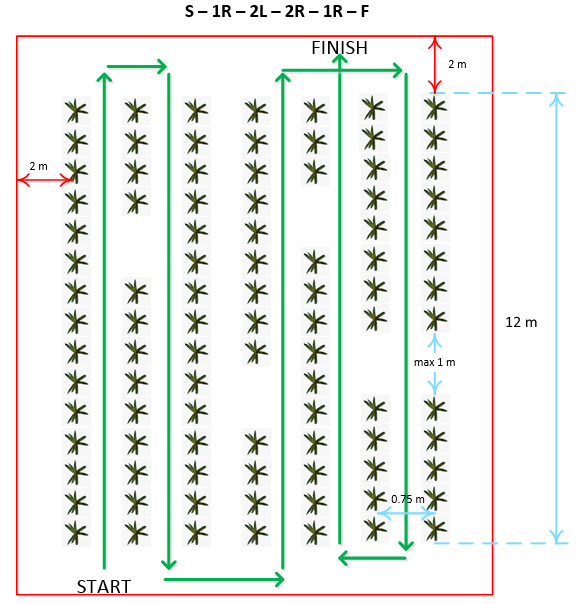General description
For this task, the robots are navigating autonomously. Under real field conditions, crop plant growth is not uniform. Furthermore, sometimes the crop rows are not even parallel. We will mimic these field conditions in the second task.
The general rules here are the same as in task 1. No large obstacles in the field, but more challenging terrain in comparison to task 1.
The robots shall achieve as much distance as possible within the duration of the task while navigating between straight (!) rows of maize plants, but the robots have to follow a certain predefined path pattern across the field (picture 3 at the end of this text).
The robot must drive the paths in a given order provided by the organisers. The code of the path pattern through the maize field is done as follows: S means START, L means LEFT hand turn, R means RIGHT hand turn and F means FINISH. The number before the L or R represents the row that has to be entered after the turn. Therefore, 2L means: Enter the second row after a left-hand turn, 3R means: Enter the third row after a right hand turn. The code for a path pattern, for example, may be given as: S – 3L – 2L – 2R – 1R – 5L – F.
A file with the code of the path pattern to be followed is made available to robot at the start. the teams two hours before the start and one hour before “submission of code”. This means one hour will be left for the teams to check the required navigation pattern in the test environments.
Virtual Field Environment
Random stones are placed in the same way as within task 1.
Additionally, at some locations, plants will be missing (row gaps) at either one or both sides with a maximum length of 1 meter. There will be no gaps in row entries as well as at the end of the rows. The ends of the rows may not be in the same line.
Rules for robots
Each robot has only one attempt. For starting, the robot is placed at the beginning of the first row without crossing the white line. The maximum available time for the run is 3 min.
Assessment
The distance travelled following the given path during task duration is measured. (As soon as the robot leaves the specified path, the distance measurement will stop.) The final distance will be calculated including especially a bonus factor when the end of the field is reached in less time than 3 min. The final distance including a bonus factor is calculated as:
Sfinal [m] = Scorrected [m] * 3 [min] / tmeasured [min]
The corrected distance includes travelled distance and the penalty values. Travelled distance, penalty values and performance time are given and measured by the jury officials.
Crop plant damage by the robot will result in a penalty of 2 % of total row length distance in meter per damaged plant. (This year example 10 x 5 m = 50 m max. distance, means a penalty of 1 m per damaged plant.)
The task completing teams will be ranked by the results of resulting total distance values. The best 3 teams will be rewarded. Points for the overall winner will be given as described under Awards.
Picture 3 shows an example of how the crop rows and the path tracks could look like for task 2. Be aware, the row gaps and the path pattern will be different during the contest.


